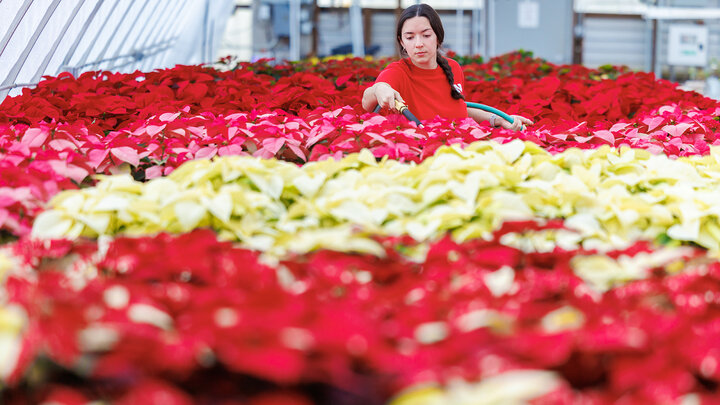Rane Parr, senior environmental engineering major at Elon University in Elon, North Carolina, spent the summer of 2023 in the University of Nebraska–Lincoln’s Research Experience Undergraduate program. The following is a blog post about her experiences.
S. Carolina Córdova, agronomy and horticulture assistant professor and Statewide Soil Health Specialist, and Stephanie Lugo, master’s student, served as Parr’s project mentors.
We tore down the rugged highway in the cabin of a white university issued truck, bouncing in our seats over the occasional pothole. Driving through rural eastern Nebraska, dwarfed cedar, cottonwood and bur oak trees dotted the side of the road, and wind turbines spun lazily along the horizon. However, the show's real stars were the vast expanses of corn and soybeans as far as the eye could see. Silos, windmills and barns showed their faces sporadically and seemed to give us a warm agrarian welcome as we passed.
We're at Haskell Agricultural Laboratory in Concord, Nebraska, on our first field day, and it's one of the most beautiful places I've ever been. Upon reaching our destination, I stepped onto the silty-clay ground and looked out upon the terraced fields of growing corn and soybeans. The sky was the biggest I'd ever seen and a bright, hazy blue, so I could tell the earth was not flat. Cirrus and cumulonimbus clouds floated without a care in the world as they came straight out of a Bob Ross painting.
My interest in agronomy comes from a place of experience, having grown up in an area of rural North Carolina that was economically devastated by agricultural pollution a few years back. Witnessing this impact on my neighbors made me want to prevent similar disasters from happening again. I decided that I wanted to pursue agricultural engineering, so I was humbled and excited when I was accepted into the summer research program at the University of Nebraska–Lincoln for Applied Plant Systems research program. I hoped that the program would help prepare me for the demands of graduate school in the future, but in the end, I gained much more than that.
Summer 2023, I worked in the Department of Agronomy and Horticulture on Nebraska’s East Campus under the mentorship of Dr. Caro Córdova. My research project focused on the long-term, no-till corn-soybean-winter wheat fields at Rogers Memorial Farm, thirty minutes from East Campus. The research aimed to determine the impact of cover crops on soil health. While there are many dimensions to soil health, my project centered on the chemical and physical properties of soil. My research question was, "How do grass and legume cover crops affect soil's chemical and physical properties in the long term under no-till agricultural management?" Rogers Memorial Farm provided the perfect place to study the impacts of cover crops on these properties, having implemented a cover crop rotation since 2005 and no-till management since the 1980s.
One of the most exciting parts of this research – in my opinion – was learning new lab procedures to analyze our samples. For example, the inorganic nitrogen content is determined by mixing extracted samples with reagents – compounds that produce a chemical reaction within a system – and measuring the amount of specific wavelengths absorbed by each sample using a photometer. These absorbances correlate with nitrate or ammonium concentrations – depending on the reagents used. This process reduces half a kilogram of soil into just a few milliliters of liquid!
Why use cover crops?
Cover crops are planted in between growing seasons and have been shown to provide ecosystem services such as erosion control, improved water infiltration, nutrient cycling, and disease prevention, as well as others. One of agriculture's main issues is the overuse of synthetic nitrogen as fertilizer. While some nitrogen is necessary for plant growth, excess nitrogen can lead to problems such as contaminated drinking water and eutrophication, which pose risks to human health. One application of cover crops is as a source of nitrogen to reduce the use of synthetic nitrogen that can harm ecosystems. After initial implementation costs, it has been posited that the use of cover crops in farm management can reduce input costs and losses associated with crop disease. While additional research is necessary to study the long-term impacts of sustainable farming practices, cover crop rotations may be useful for increasing crop yields to feed a growing population and helping farmers preserve their livelihoods for generations to come.
Not only did I engage in my research project, but I had the opportunity to assist with other projects, such as the one at Haskell Agricultural Laboratory, where I was able to conduct formal fieldwork for the first time. I later learned that helping others in one's spare time is common in graduate student lab groups. In addition to research activities, the program offered a few weekend excursions, including the Omaha Zoo and a minor league baseball game. Lincoln had plenty to offer, too, with downtown being just a five-minute walk from the dorms and fun events happening every weekend. Nebraska also hosts many recreational areas nearby that provide a nice break from the city.
By participating in this program, not only did I confirm my desire to go to graduate school, but I also learned more about other opportunities, such as volunteer service. Additionally, I learned more about a mentor's role in hopes that it can increase my mentoring capacity in my final year of university, as well as about the role of research in society. Participating in this program helped me to increase my confidence as a researcher, make connections within and outside of my field, and prepare for the next steps of my career. It was a fun and eventful summer!
Mason Schumacher (left), Dr. Caro Córdova, Stephanie Lugo, and Rane Parr at Rogers Memorial Farm.
Rane Parr (left) and Stephanie Lugo working in the Córdova lab.




